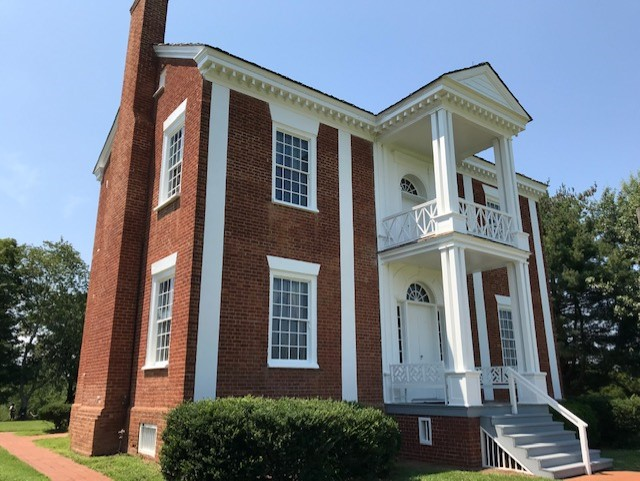
The Vann House in Chatsworth, Georgia, is one of 18 new listings added to the Underground Railroad Network to Freedom:
NPS/Jackson
Staff Report –
WASHINGTON, D.C. – The National Park Service recently announced 18 new additions to the Underground Railroad Network to Freedom in 11 states to further provide insight into the experiences of freedom seekers who escaped slavery, along with those who assisted them.
“The stories of freedom seekers, who risked everything to claim their liberty, inspire us every time we review Network to Freedom applications,” National Park Service Deputy Director Shawn Benge said in the press release announcing the additions.
“The new listings remind us of the power Underground Railroad histories hold today and we are eager to work alongside our new members sharing Underground Railroad history with the public,” he said.
Georgia
Vann House [site], located in present day Chatsworth, is the historic home of Cherokee Chief James Vann and the largest plantation in the Cherokee Nation. Vann enslaved at least 100 Black individuals, many of whom escaped. Moravian missionaries, brought to proselytize and instruct Cherokee children, also lived on his plantation and recorded stories of freedom seekers. In 1835, the Vann family along with other Cherokees were forced west on the Trail of Tears to Oklahoma.
Alabama
Fort Gaines [site] is a site where freedom seekers escaped from during its construction and escaped to the fort during the Civil War.
Advertisements in local newspapers highlight the escapes of freedom seekers Eli, Alfred, and Edmond. The U.S. Navy took freedom seeker Wallace Turnage to Fort Gaines from Mobile Bay, where he was given the choice to enlist or hire himself to a Union officer. He chose the latter.
Turnage published his story in A Slave No More: Two Men Who Escaped to Freedom Including Their Own Narratives of Emancipation.
Hal’s Kingdom Marker [site] recognizes Hal, a self-emancipated man, and the Maroon colony established under his leadership. When the community was discovered and in danger of being captured, Hal and his fellow freedom seekers refused to surrender willingly. Hal was shot and subsequently died from his injuries.
Florida
Pensacola Pass [site], a shipping channel in Pensacola, Florida, served as a transportation route on the Underground Railroad in the mid-1800s.
For example, in 1844, a white abolitionist named Jonathan Walker sailed seven freedom seekers—including Charles, Moses, Philip, & Leonard Johnson, Silas & Harry Scott, and Anthony Catlett—through the pass on their journey to the British Bahamas. Six years later, freedom seeker Adam secretly boarded a ship traveling to Portsmouth, New Hampshire. After an altercation, Portsmouth’s abolitionists rushed Adam to Canada. Today, the site is part of Gulf Islands National Seashore.
Illinois
Graceland Cemetery [site], founded in 1860, is the final resting place of at least 28 Underground Railroad activists.
Among the most prominent are Mary Richardson Jones (1820-1910) and her husband John Jones (1816-1879). Free African Americans, the Joneses migrated to Chicago in the 1840s, are counted among the city’s most active Underground Railroad operatives, and shared a life-long commitment to the struggle for civil rights.
Iowa
Newton Union Cemetery [site] is an urban cemetery in Newton, Iowa. Established in 1854, 10 freedom seekers who escaped from Missouri during the early 1860s are buried here.
Eight freedom seekers continued in the struggle against slavery, enlisting in the 60th United States Colored Troops and serving during the Civil War.
Woodland Cemetery [site] in Des Moines is the burial site of 15 Underground Railroad operatives and freedom seekers. For example, Isaac Brandt was active in the Underground Railroad. Jefferson Logan, a freedom seeker from Missouri who Brandt aided, became a well-known Underground Railroad operative in the area. Another notable operative buried here is Delia Webster, whose activity took place else where, but passed away in Des Moines.
Kansas
Freedom’s Frontier National Heritage Area (FFNHA) [program], authorized by Congress in 2006, works with the National Park Service and local organizations to tell important stories of the region relating to the enduring struggle for freedom, including the Underground Railroad.
Maryland
Mount Clare Station [site] is along a rail line used by known and unknown enslaved Americans on their journeys to freedom. Well known freedom seekers including Henry “Box” Brown and William and Ellen Craft passed through this location.
Eliza Howard Parker and Family Escape Site at Bellevue Farm [site] is where in 1846-1847, Eliza Howard, her mother and siblings took their freedom. Eliza participated in the Christiana Resistance of September 11, 1851, when a Maryland enslaver was killed in pursuit of his enslaved property. The battle took place at Eliza’s new home in the Pennsylvania town where she lived with husband John Parker and young family.
Elkridge Furnace [site] was one of the largest operating iron furnaces in colonial Maryland, and used enslaved, indentured, and convict labor. At least five people escaped from this site. Some individuals escaped multiple times and suffered severe punishment, but persisted in pursuit of freedom.
Henry Massey Escape Site [site] at the Stoopley-Gibson Plantation is where this 14 year old boy escaped enslavement in 1849. Massey was identified as a runaway slave in Harrisburg, Pennsylvania, five years later. Despite legal representation by the Pennsylvania Abolition Society, Massey was convicted at trial and returned to his enslaver.
Michigan
The Jackson, Michigan Central Railroad (MCRR) Corridor [site] is where, during the mid-1800s, a stretch of rail in Jackson connected a passenger depot on the west to a freight depot on the east, which provided access to and passage for freedom seekers, like the Crosswhite family, who escaped by rail to Detroit.
New York
Bowne House Historical Society [facility] hosts documents which reveal three Bowne family members – Samuel, Robert, and William Bowne Parsons – were active in a network assisting multiple freedom seekers. The letters of this Quaker family document their contacts with prominent Underground Railroad activists.
Ohio:
Decatur Cemetery [site] is the final resting place of two well-known local Underground Railroad operatives, Dr. Greenleaf Norton (1793-1869) and Rev. Jesse Lockhart (1793-1879), and two freedom seekers who escaped from Kentucky during the Civil War, Lemuel Parker (c. 1850-1941) and Mrs. Phoebe Rice Duckins (d.1918).
Uri B. Seeley House [site] was the home of Uri Seeley (1791-1877). Seeley had a most fierce hatred of slavery, and provided food, shelter, transportation, and financial support to freedom seekers. Underground Railroad historian Wilbur H. Siebert referred to Seely’s home as “a Fugitive Retreat.”
Wilson Bruce Evan House [site], located in the historic interracial antislavery stronghold of Oberlin, was the home of Wilson Bruce Evans, a free man of color. In 1858, Evans and 36 others participated in the “Oberlin-Wellington Rescue,” after which they were arrested for preventing the recapture of freedom seeker John Price. During the Civil War, Evans served in the Union Army after which he returned to Oberlin and lived in the house until his death.
South Carolina
Seizure of the Planter Marker [site] commemorates Robert Smalls, his family, and the families of other freedom seekers who commandeered the C.S.S. Planter from the Charleston Harbor. On May 12, 1862, the Planter′s three white officers decided to spend the night ashore. In the early hours of morning, Smalls and seven enslaved crewmen decided to escape. Smalls sailed the Planter out of what was then known as Southern Wharf, stopping only to pick up his own family and the families of other crewmen. This action helped secure their freedom.
The National Underground Railroad Network to Freedom serves to honor, preserve, and promote the history of resistance to enslavement through escape and flight, which continues to inspire people worldwide.
The Network currently represents over 695 locations in 39 states, plus Washington D.C. and the U.S. Virgin Islands. Through its mission, the Network to Freedom helps to advance the idea that all human beings embrace the right to self-determination and freedom from oppression.
Many Network to Freedom listings are privately owned and not open to the public. If not, the agency requests that the public respect the privacy of the owner.
More than 20,000 National Park Service employees care for America’s 423 national parks and work with communities across the nation to help preserve local history and create close-to-home recreational opportunities. Learn more at NPS.Gov as well as social media sites such as Facebook, Instagram, Twitter and YouTube.














Thank you for this. I was interested in the Cherokee history when visited before. We didn’t have long. So I looked it up after the article.
Very interesting.
https://www.murraycountymuseum.com/vann.html
I met a visitor at my park who had a lot of pictures of the Vann House and the Vanns. His Fiancé was descending from the first white family that moved into the house. He was a descendant of the Vanns. They were comparing photo albums when it came up. He told me that story at Little River Falls parking lot. That was an interesting visitor. I wish now I had gotten their contact info now. All it is is a good story they might have gotten married there or nearby… I cannot remember details if there were any.